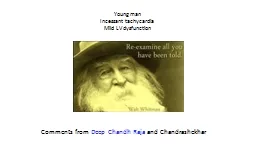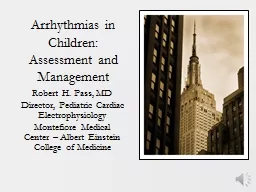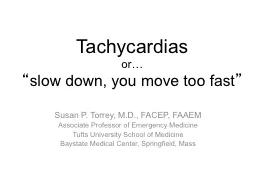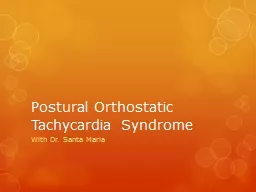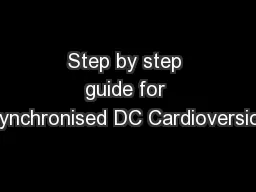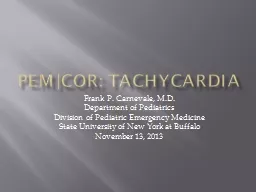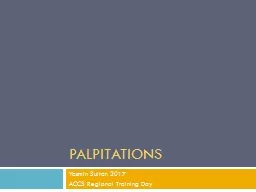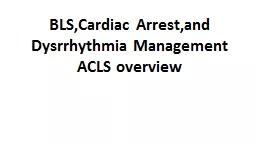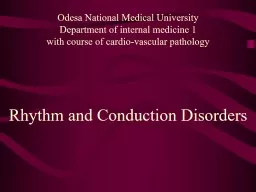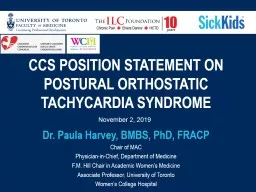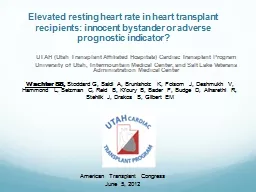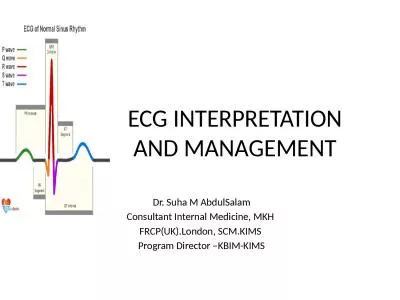PPT-Young man Incessant tachycardia
Author : GorgeousGirl | Published Date : 2022-08-04
Mild LV dysfunction Comments from Deep Chandh Raja and Chandrashekhar DD Long RP tachycardia P inverted in III aVL V6 ve in aVR terminally ve in V1 the activation
Presentation Embed Code
Download Presentation
Download Presentation The PPT/PDF document "Young man Incessant tachycardia" is the property of its rightful owner. Permission is granted to download and print the materials on this website for personal, non-commercial use only, and to display it on your personal computer provided you do not modify the materials and that you retain all copyright notices contained in the materials. By downloading content from our website, you accept the terms of this agreement.
Young man Incessant tachycardia: Transcript
Mild LV dysfunction Comments from Deep Chandh Raja and Chandrashekhar DD Long RP tachycardia P inverted in III aVL V6 ve in aVR terminally ve in V1 the activation starts low left . Arrhythmias. Objectives. Describe the normal conduction in the heart. Describe pathophysiology of . bradycardias. Describe pathophysiology of . tachycardias. Describe treatment of the above. Case. A 55 year old male calls 911 because his “heart is racing.” He initially is alert, oriented, and has mild shortness of breath. On physical exam, he has a regular tachycardia at 180, and monitor shows a regular, narrow-complex tachycardia. He denies chest pain. Midway through transport, he becomes less responsive, and his blood pressure drops as he starts sweating profusely.. Assessment and Management. Robert H. Pass, MD. Director, Pediatric Cardiac Electrophysiology. Montefiore Medical Center – Albert Einstein College of Medicine. Pediatric Arrhythmia Management. Bradycardia. or…. “. slow down, you move too fast. ”. Susan P. Torrey, M.D., FACEP, FAAEM. Associate Professor of Emergency Medicine. Tufts University School of Medicine. Baystate. Medical Center, Springfield, Mass. With Dr. Santa Maria. What is POTS?. What symptoms fall under the umbrella of POTS?. What would be “specific” versus “nonspecific” symptoms of . dysautonomia. ?. What is the autonomic nervous system and how does it work?. By: Martin Grant. Student no. 40077467. Cardioversion is defined as a “. synchronised direct current (DC) . discharge, and … does not apply to ventricular defibrillation or to the pharmacologic reversion of arrhythmias. Department of Pediatrics. Division of Pediatric Emergency Medicine. State University of New York at Buffalo. November 13, 2013. PEM|CoR. : 2013-2014. 09-18-13: Hypovolemic & Distributive Shock. 10-30-13: Cardiogenic & Obstructive Shock. ACCS Regional Training Day. What are palpitations?. Heart . palpitations. are the feelings of the heart beating rapidly, forcefully, irregularly, skipping beats or fluttering. Has different meanings for different patients.. . Dysrrhythmia. Management. ACLS overview. Bradycardia. Evaluation. Bradycardia. is defined as a heart rate of . <60 beats/ min. . However, when . bradycardia. is the cause of . symptoms,the. . Odesa National Medical University. Department of internal medicine 1. with course of cardio-vascular pathology. ARRHYTHMIA. Definition of Arrhythmia:. The . Origin, Rate, Rhythm, Conduct velocity and sequence. Dr. Paula Harvey, BMBS, PhD, FRACP. Chair of MAC. Physician-in-Chief, Department of Medicine. F.M. Hill Chair in Academic Women’s Medicine. Associate Professor, University of Toronto. Women’s College Hospital. UTAH (Utah Transplant Affiliated Hospitals) Cardiac Transplant Program. University of Utah, Intermountain Medical Center, and . Salt Lake . Veterans . Administration Medical Center. Wachter SB. , . Stoddard G, . Of these, reentry is responsible for the majority of clinical arrhythmias. It should be recognized that the mechanism responsible for initiation of an arrhythmia might be different than the mechanis If you make a mistake sooner or later you will have to atone for it.. Bondage (n.) – slavery; any state of being bound or held down. The triangular trade routes placed many human beings into a state of bondage. Dr. Suha M AbdulSalam. Consultant Internal Medicine, MKH . FRCP(UK).London, SCM.KIMS . Program Director –KBIM-KIMS. Objectives. Basic anatomy and physiology. Normal ECG. Abnormal ECG. A. rrhythmias .
Download Document
Here is the link to download the presentation.
"Young man Incessant tachycardia"The content belongs to its owner. You may download and print it for personal use, without modification, and keep all copyright notices. By downloading, you agree to these terms.
Related Documents

